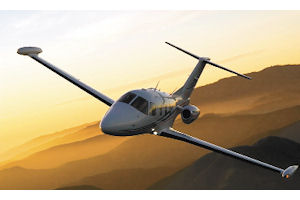If very light jets take flight in the business aviation market, the hefty expense of owning a corporate jet may get a little lighter, too. About the size of a sports utility vehicle, flown by a single pilot, and costing about $2.1 million, these aircraft created a lot of buzz when introduced by Eclipse Aviation in 2006. The recession, however, grounded that interest and the plane never reached the forecast production numbers. It’s the only plane classified as a very light jet. Still, the Eclipse and other aircraft of similar size are generating interest in business aviation circles, because they give access to people who might not otherwise afford it. Charter aircraft companies emphasize the benefits of flying on a corporate jet — speed, efficiency and privacy — to woo business people to use their services. It’s often a tough sell, especially in this budget-conscious business climate. But convincing professionals to plop down millions for their own plane is even more challenging; though, some say once fliers experience the luxury of private flight they remain a customer for life. “The experience is the only way to find out,” said Danielle Boudreau, a spokesperson for Bombardier, maker of the Lear Jet and other business aircraft. That may be true. However, the group of travelers who have the financial wherewithal and the need to fly privately is pretty small. There are about 15,000 registered business aircraft in the U.S., according to the 2011 Business Aviation Fact Book, released by the National Business Aviation Association. Plus, there’s a variety of private flying options available, ranging from the one-time charter flight to leasing to fractional ownership with a set number of flying hours to full ownership of an airplane. Very light and entry-level jets Charter remains the typical entry point for the business flyer. When it comes to ownership, the entry point has become affordable for even modestly small companies with onset of the very light jet and other entry-level models. Starting in 2006, the hype of the Eclipse jet was that it was the new model in business aviation. Eclipse Aviation, a New Mexico company furthest along in building these jets, had backorders in the thousands. Then the recession came along and interest came to a screeching halt. Eclipse Aviation only made a couple hundred planes before filing for bankruptcy in 2008. A new company, Eclipse Aerospace, emerged with the assets and returned to making new aircraft albeit at slower pace. Other aircraft manufacturers have their own very light jets in the development stage. Jet-Alliance, a Westlake Village firm specializing in chartering and managing entry-level and very light jets, lists an Eclipse 500 for $2 million on its website. The site lists an Embraer Phenom 100 at $3.2 million and a Cessna Citation Mustang at $3 million. Both planes are slightly larger than the Eclipse and are considered to be entry-level aircraft. Those prices are typical for an almost new plane of those models, said Jet-Alliance Chairman Randall Sanada. New aircraft in the light business jet category are generally available for less than $10 million. Most mid-size jets sell for new in the mid- to high-teens. Advances in plane designs and technology now make it capable for smaller planes to be as fast and quiet as larger ones. The result is that business people who frequently use corporate jets are downsizing to the smaller planes. “There is a significant number of people who have flown in larger aircraft, and now (they) have the availability of a smaller one that is just as fast and as efficient,” Sanada said. From the perspective of Piaggio Aero, if a business owner or corporation wants speed, fuel efficiency and roominess there is no need for a jet, per se. For $7.1 million the Avanti II turboprop provides all three, said John Bingham, president and CEO of Piaggio America and chief marketing officer for Piaggio Aero. In marketing the aircraft, the company emphasizes operating costs and speeds as being comparable with smaller jets. Available in the U.S. for about five years, the Avanti II is a popular model for owner upgrading from smaller aircraft. However, buyers occasionally trade down to the aircraft from a larger model, Bingham said. Bombardier’s broad product line means a satisfied owner never has to switch manufacturers when they want to upgrade, Boudreau said. The company’s entry-level jet is the Leer 40XR, which prices for about $9.2 million.
